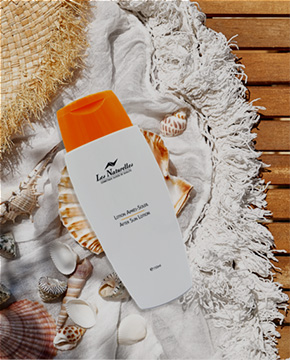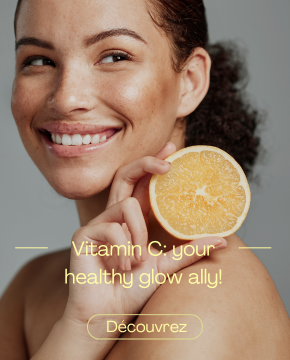CHOOSING THE RIGHT SOLAR PRODUCTS: A CHALLENGE
As the sun's rays warm up and the days get longer, the urge to enjoy the great outdoors grows stronger and stronger. However, prolonged exposure to the sun can cause irreparable damage to the skin, underlining the crucial importance of adequate sun protection. In this article, we take an in-depth look at sunscreens, highlighting the differences between mineral and chemical filters, the distinction between UVA and UVB rays, the Indice de Protection Solaire (IPS in French and SPF in English) and practical tips for safe, effective use.
UVA and UVB ... What's the difference?
Ultraviolet (UV) rays emitted by the sun fall into two main categories: UVA and UVB rays. Although both are harmful to the skin, they differ in their characteristics and effects on health. Here are the main differences between UVA and UVB rays:
- UVA rays are present all year round and can penetrate through clouds and glass, meaning that exposure to UVA rays can occur even on cloudy days or indoors. They penetrate deep into the skin, reaching the deep layers of the dermis. UVA rays can contribute to sunburn, but they are more associated with long-term effects such as premature aging of the skin, hyperpigmentation and suppression of the cutaneous immune system.
- UVB rays are most intense during the sun's peak hours, generally between 10 a.m. and 4 p.m., and are more prevalent during the summer months. They penetrate less deeply, affecting mainly the superficial layers of the epidermis. UVB rays are mainly responsible for sunburn and short-term skin damage, such as redness, burns and blisters. UVB rays are a major factor in the development of skin cancer, including basal cell carcinoma, squamous cell carcinoma and melanoma.

In short, although UVA and UVB rays are both harmful to the skin, they differ in their effects and intensity. It is therefore important to protect against both types of rays by using broad-spectrum sun creams and limiting sun exposure, especially during peak hours.

The Sun Protection Factor (SPF): A Crucial Safety Measure
The SPF is a measure of a sunscreen's effectiveness in protecting the skin against UVB rays. It is laboratory-tested for every sunscreen on the market. The higher the SPF, the greater the protection against sunburn. For example, a sunscreen with an SPF of 50 blocks around 98% of UVB rays, meaning that it will take around 50 times longer to get sunburned than if you hadn't applied any sunscreen at all. For example, if in a tropical sun you get sunburned in 10 minutes (which is common in the tropics), with a perfectly applied SPF50 sun cream, you would have caught the same sunburn in 10 x 50 minutes, or around 8 hours.
It's recommended to use a sunscreen with an SPF of at least 30 for adequate protection against sun damage. However, it's important to remember that SPF only measures protection against UVB rays, while UVA rays can also cause long-term damage to the skin. For complete protection, look for broad-spectrum sunscreens that protect against both UVB and UVA rays.
In general, when you see an SPF followed by a "+" symbol, this means that the product offers greater protection than the SPF specified.
Mineral Filters versus Chemical Filters: An Informed Choice
Sun creams use different types of filters to protect the skin against UV rays. Mineral filters, such as zinc oxide and titanium dioxide, act by creating a physical barrier that reflects the sun's rays, offering protection against UVA and UVB rays. However, to be effective, these mineral filters need to be applied in an unsightly, rather sticky white layer that needs to be renewed often.
Chemical filters, on the other hand, absorb UV rays, neutralizing them before they can cause damage. Although these filters offer effective protection, some people may be sensitive to their ingredients and develop skin reactions.
The limitations of chemical filters
Although chemical sunscreens are widely used and offer effective protection against UV rays, they also have certain limitations and concerns that are worth considering:
1. Skin reactivity: Some chemical ingredients used in sunscreens may cause allergic reactions or skin irritation in some people, particularly those with sensitive or allergy-prone skin.
2. Skin absorption: Chemical sunscreens are designed to be absorbed by the skin to neutralize UV rays. As such, they are potentially more risky than mineral filters, which are less likely to penetrate.
3. Degradation under Sun Exposure: Some chemical sunscreens can degrade under direct sun exposure, losing their protective efficacy. This can lead to a reduction in the sunscreen's ability to protect the skin against UV rays, necessitating more frequent application to maintain adequate protection, and the use of a sunscreen product that has not expired and is kept away from excessive heat.
4. Environmental impact: Chemical sunscreens can also have an impact on the environment when rinsed in water, particularly in oceans and rivers. Some chemical ingredients have been associated with adverse effects on marine ecosystems, such as coral bleaching and disturbance of marine organisms. For this reason, some chemical filters are banned, for example in Australia.
In summary, although chemical sunscreens are widely used and considered safe and effective in protecting the skin against UV rays, they nevertheless present limitations and concerns in terms of skin reactivity, skin absorption, degradation under sun exposure and environmental impact. It is therefore important to choose suncare products with these factors in mind, and to follow the recommendations for use and storage for optimum skin protection.
The limitations of mineral filters
Although mineral sunscreens offer effective protection against UV rays, they also have certain limitations that are worth considering:
1. Texture and white appearance: sunscreens containing mineral filters can have a thicker, often sticky texture, leaving a white film on the skin. This can be perceived as unsightly, particularly on darker skins, and may deter some people from using them.
2. Sensitization potential: although mineral filters are generally considered less prone to allergies than chemical filters, some people may still experience skin reactions or irritation after using them. This may be due to allergies to certain components of mineral filters, such as preservatives, or to particular skin sensitivities.
3. Difficulty of application: due to their thicker texture, sunscreens containing mineral filters may be more difficult to apply evenly to the skin, particularly on parts of the body covered with hair or denser pilosity.
4. Degradation potential: sunscreens containing mineral filters do not last as long, and need to be reapplied more often when swimming, perspiring heavily or rubbing against clothing.
5. Lower UVA protection: compared with chemical filters, mineral filters generally offer lower UVA protection.
6. Lower UVB Protection: Compared with chemical filters, mineral filters generally offer lower UVB protection, up to SPF30.
Practical Tips: Safe and Effective Use
As well as choosing the right sun cream, it's also important to follow a few practical tips for safe and effective use.
Firstly, make sure you apply enough sunscreen to cover the entire exposed surface of your skin, and especially for mineral filter creams, reapply every two hours, or more often if you're swimming or sweating heavily.
Secondly, avoid storing sunscreen for more than a year. Most sunscreens have a maximum shelf life of around one year. Beyond this period, the active ingredients can begin to degrade, making them toxic or reducing the sunscreen's effectiveness. In particular, never use a sunscreen whose ingredients have separated.
In conclusion, sunscreens play a crucial role in protecting our skin from sun damage. By understanding the differences between mineral and chemical filters, choosing a high SPF and following practical advice for safe use, you can enjoy the great outdoors safely while preserving the health of your skin.

A selection of bad ideas ....
Here are a few very common practices that should be avoided altogether...
1: "I'm running out of sun, so I'm going to stock up on vitamin D".
This is a very bad idea, and the best way to ruin your vacation. Your skin hasn't had time to naturally protect itself from the sun. So, opt for moderate exposure and 50+ protection ... even on the last day, when you won't come back with a nice tan, but rather burnt and dehydrated from the plane trip.
2. "I've got a leftover bottle of sunscreen from last year, and it'll do for the start of summer".
Another bad idea! Unless you've kept your sunscreen in the fridge, and it's still homogeneous and smells the same (which indicates product deterioration and possibly bacterial infection), it's essential to use a recent product and never use a product whose components have separated, even if it looks homogeneous when shaken. This is not a marketing argument: a separated product is ineffective, and even dangerous, as the filters degrade into harmful ingredients. Our advice: replace your sunscreens every year at the most, and avoid leaving them for hours in the sun or in the car at 60°.
3. What about tanning oil with an SPF of less than 30?
Absolutely not. You're not a French fry.
4. "It's overcast, I don't need sunscreen" or "I don't need sunscreen because I'm staying on the beach, protecting myself under my parasol".
Another mistake. It's forgetting about reverberation and the fact that some UVB and especially UVA rays are not stopped by an umbrella or clouds.
5. "I already have tanned or colored skin, so I don't need sunscreen".
Also false, even though tanned or black skins have some natural protection against sun damage due to their higher pigmentation, they still need to use sunscreen to protect against sunburn, UVA and premature skin aging, blotchiness, skin cancer and other harmful effects of the sun.
6. "If I use a cream with SPF 15 or 30, I'll tan much faster than if I use SPF 50+".
Not really. You'll tan almost as quickly with SPF 50+, but you'll protect your skin much more effectively against aging and melanoma, and your tan will last much longer. So why not always use a high SPF? ... that's our advice ...
Predige's choices
With over 45 years' experience in cosmetics, and aware of the ravages on the skin of overexposure to the sun, we have made the following choices for maximum safety and radiance for your skin:
1. As the safety of our customers comes first, we prefer broad-spectrum chemical filters. Based on our tests and experience, they have proved to be more effective and safer than mineral filters. If we thought that mineral filters offered sufficient safety, we would offer them in our formulas, but this is not the case.
What's more, we've selected not only the safest UVA and UVB filters, but also the safest preservatives and excipients, effective in providing long-lasting hydration and protection for your skin.
2. We recommend always using a high protection factor, at least 30 and preferably 50+. You'll tan almost as quickly, your tan will last longer, and your skin will be less stressed and more radiant.
3. We've developed a soothing, repairing complex specially formulated for sun-damaged skin. By moisturizing your skin, you prolong its radiance, elasticity and tan.
4. If you're going to the mountains or the tropics... A single reflex: a 50+ protection factor from the first to the last day, after sun in the evening and before taking the plane, then on arrival. This is the secret to an even, long-lasting tan and melanoma-free skin.
5. Predige sun creams are designed to protect not only against UVB, but also against UVA, which causes long-term damage.
Our simple tips for making the most of the sun and sunny days:
- Use a recent SPF50+ cream
- Reapply regularly, ideally every 2 to 3 hours, depending on the conditions.
- Moisturize your skin in the evening with an after-sun lotion, before and after air travel.





